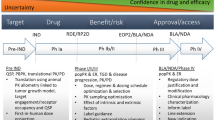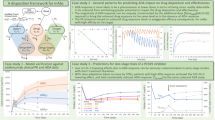Abstract
Purpose of Review
Monoclonal antibodies targeting key checkpoints in immune stimulatory pathways have over the last years become the mainstay of cancer immuno-therapy. This article provides a brief review of the application and key impact of pharmacometrics and quantitative clinical pharmacology approaches in the development of these novel biologics.
Recent Findings
The clinical development and selection of optimal dosing regimens for monoclonal antibodies used in immuno-oncology has been facilitated by an extensive application of pharmacometric approaches to characterize the exposure-response relationship for major efficacy and safety endpoints. These analysis techniques were applied for the anti-CTLA-4 antibody ipilimumab, as well as the anti-PD1/PD-L1 antibodies nivolumab, pembrolizumab, avelumab, atezolizumab, and durvalumab. The utilization of quantitative clinical pharmacology, including model-based analyses, did not only support the identification of efficacious doses with acceptable safety limits but was also able to address complicating challenges such as time- and response-dependent changes in antibody clearance as observed for most compounds.
Summary
A widespread and systematic application of pharmacometric approaches has provided key aspects in elucidating, interpreting, and integrating preclinical, biochemical, and clinical data in support of the development of safe and efficacious dosing regimens of monoclonal antibodies used in immuno-oncology, thereby facilitating the clinical use of this promising new class of biologics in cancer patients with unmet medical needs.
Similar content being viewed by others
References
Papers of particular interest, published recently, have been highlighted as: • Of importance
Couzin-Frankel J. Breakthrough of the year. Cancer immunotherapy. Science. 2013;342(6165):1432–3.
Hoos A. Development of immuno-oncology drugs—from CTLA4 to PD1 to the next generations. Nat Rev Drug Discov. 2016;15(4):235–47.
Chen DS, Mellman I. Oncology meets immunology: the cancer-immunity cycle. Immunity. 2013;39(1):1–10.
Sachs JR, Mayawala K, Gadamsetty S, Kang SP, de Alwis DP. Optimal dosing for targeted therapies in oncology: drug development cases leading by example. Clin Cancer Res. 2016;22(6):1318–24.
Agrawal S, Feng Y, Roy A, Kollia G, Lestini B. Nivolumab dose selection: challenges, opportunities, and lessons learned for cancer immunotherapy. J Immunother Cancer. 2016;4:72.
Postel-Vinay S, Aspeslagh S, Lanoy E, Robert C, Soria JC, Marabelle A. Challenges of phase 1 clinical trials evaluating immune checkpoint-targeted antibodies. Ann Oncol. 2016;27(2):214–24.
Zhang L, Pfister M, Meibohm B. Concepts and challenges in quantitative pharmacology and model-based drug development. AAPS J. 2008;10(4):552–9.
Venkatakrishnan K, Friberg LE, Ouellet D, Mettetal JT, Stein A, Trocóniz IF, et al. Optimizing oncology therapeutics through quantitative translational and clinical pharmacology: challenges and opportunities. Clin Pharmacol Ther. 2015;97(1):37–54.
Mould DR, Meibohm B. Drug development of therapeutic monoclonal antibodies. BioDrugs. 2016;30(4):275–93.
• Buil-Bruna N, Lopez-Picazo JM, Martin-Algarra S, Troconiz IF. Bringing model-based prediction to oncology clinical practice: a review of pharmacometrics principles and applications. Oncologist. 2016;21(2):220–32. An introductory review on the application of pharmacometric principles in oncology.
Venkatakrishnan K, Ecsedy JA. Enhancing value of clinical pharmacodynamics in oncology drug development: an alliance between quantitative pharmacology and translational science. Clin Pharmacol Ther. 2017;101(1):99–113.
Stroh M, Carlile DJ, Li CC, Wagg J, Ribba B, Ramanujan S, et al. Challenges and opportunities for quantitative clinical pharmacology in cancer immunotherapy: something old, something new, something borrowed, and something blue. CPT Pharmacometrics Syst Pharmacol. 2015;4(9):495–7.
Feng Y, Masson E, Dai D, Parker SM, Berman D, Roy A. Model-based clinical pharmacology profiling of ipilimumab in patients with advanced melanoma. Br J Clin Pharmacol. 2014;78(1):106–17.
Feng Y, Roy A, Masson E, Chen TT, Humphrey R, Weber JS. Exposure-response relationships of the efficacy and safety of ipilimumab in patients with advanced melanoma. Clin Cancer Res. 2013;19(14):3977–86.
Hodi FS, O’Day SJ, McDermott DF, et al. Improved survival with ipilimumab in patients with metastatic melanoma. N Engl J Med. 2010;363(8):711–23.
Ascierto PA, Del Vecchio M, Robert C, et al. Ipilimumab 10 mg/kg versus ipilimumab 3 mg/kg in patients with unresectable or metastatic melanoma: a randomised, double-blind, multicentre, phase 3 trial. Lancet Oncol. 2017;18(5):611–22.
Wang C, Thudium KB, Han M, Wang XT, Huang H, Feingersh D, et al. In vitro characterization of the anti-PD-1 antibody nivolumab, BMS-936558, and in vivo toxicology in non-human primates. Cancer Immunol Res. 2014;2(9):846–56.
Brahmer JR, Drake CG, Wollner I, Powderly JD, Picus J, Sharfman WH, et al. Phase I study of single-agent anti-programmed death-1 (MDX-1106) in refractory solid tumors: safety, clinical activity, pharmacodynamics, and immunologic correlates. J Clin Oncol. 2010;28(19):3167–75.
Morrissey KM, Yuraszeck TM, Li CC, Zhang Y, Kasichayanula S. Immunotherapy and novel combinations in oncology: current landscape, challenges, and opportunities. Clin Transl Sci. 2016;9(2):89–104.
• Bajaj G, Wang X, Agrawal S, Gupta M, Roy A, Feng Y. Model-based population pharmacokinetic analysis of nivolumab in patients with solid tumors. CPT Pharmacometrics Syst Pharmacol. 2017;6(1):58–66. An illustrative example on a model-based pharmacometric approach to describe and evaluate time-dependent pharmacokinetics of a monoclonal antibody.
Wang Y, Booth B, Rahman A, Kim G, Huang SM, Zineh I. Toward greater insights on pharmacokinetics and exposure-response relationships for therapeutic biologics in oncology drug development. Clin Pharmacol Ther. 2017;101(5):582–4.
Zhao X, Suryawanshi S, Hruska M, Feng Y, Wang X, Shen J, et al. Assessment of nivolumab benefit-risk profile of a 240-mg flat dose relative to a 3-mg/kg dosing regimen in patients with advanced tumors. Ann Oncol. 2017;28(8):2002–8.
de Greef R, Elassaiss-Schaap J, Chatterjee M, Turner DC, Ahamadi M, Forman M, et al. Pembrolizumab: role of modeling and simulation in bringing a novel immunotherapy to patients with melanoma. CPT Pharmacometrics Syst Pharmacol. 2017;6(1):5–7.
Elassaiss-Schaap J, Rossenu S, Lindauer A, Kang SP, de Greef R, Sachs JR, et al. Using model-based “learn and confirm” to reveal the pharmacokinetics-pharmacodynamics relationship of pembrolizumab in the KEYNOTE-001 trial. CPT Pharmacometrics Syst Pharmacol. 2017;6(1):21–8.
Patnaik A, Kang SP, Rasco D, Papadopoulos KP, Elassaiss-Schaap J, Beeram M, et al. Phase I study of pembrolizumab (MK-3475; anti-PD-1 monoclonal antibody) in patients with advanced solid tumors. Clin Cancer Res. 2015;21(19):4286–93.
Lindauer A, Valiathan CR, Mehta K, Sriram V, de Greef R, Elassaiss-Schaap J, et al. Translational pharmacokinetic/pharmacodynamic modeling of tumor growth inhibition supports dose-range selection of the anti-PD-1 antibody pembrolizumab. CPT Pharmacometrics Syst Pharmacol. 2017;6(1):11–20.
Freshwater T, Kondic A, Ahamadi M, Li CH, de Greef R, de Alwis D, et al. Evaluation of dosing strategy for pembrolizumab for oncology indications. J Immunother Cancer. 2017;5:43.
Li HS, Yu JY, Liu C, Liu J, Subramaniam S, Zhao H, et al. Time dependent pharmacokinetics of pembrolizumab in patients with solid tumor and its correlation with best overall response. J Pharmacokinet Pharmacodyn. 2017;44(5):403–14.
Hamilton G, Rath B. Avelumab: combining immune checkpoint inhibition and antibody-dependent cytotoxicity. Expert Opin Biol Ther. 2017;17(4):515–23.
Heery CR, O’Sullivan-Coyne G, Madan RA, Cordes L, Rajan A, Rauckhorst M, et al. Avelumab for metastatic or locally advanced previously treated solid tumours (JAVELIN solid tumor): a phase 1a, multicohort, dose-escalation trial. Lancet Oncol. 2017;18(5):587–98.
Wilkins J, Wang S, Brockhaus B, et al. Clearance over time and effect of response in the pharmacokinetics of avelumab. American Conference on Pharmacometrics 8, Fort Lauderdale, FL, 2017. http://medpub-poster.merckgroup.com/ACOP2017_W-079.pdf. Accessed 7 Dec 2017.
Gulley JL, Spigel DR, Kelly K, et al. Exposure-response and PD-L1 expression analysis of second-line avelumab in patients with advanced NSCLC: data from the JAVELIN solid tumor trial. J Clin Oncol. 2017;35(15 suppl):9086.
Heery CR, O’Sullivan Coyne G, Marte JL, et al. Pharmacokinetic profile and receptor occupancy of avelumab (MSB0010718C), an anti-PD-L1 monoclonal antibody, in a phase I, open-label, dose escalation trial in patients with advanced solid tumors. J Clin Oncol. 2015;33(15_suppl):3055.
Stroh M, Winter H, Marchand M, Claret L, Eppler S, Ruppel J, et al. Clinical pharmacokinetics and pharmacodynamics of atezolizumab in metastatic urothelial carcinoma. Clin Pharmacol Ther. 2017;102(2):305–12.
Food and Drug Administration. Tecentriq (atezolizumab) clinical pharmacology biopharmaceutics review. Silver Spring: U.S. Department of Health and Human Services 2016. https://www.accessdata.fda.gov/drugsatfda_docs/nda/2016/761034Orig1s000ClinPharmR.pdf. Accessed 7 Dec 2017.
Syed YY. Durvalumab: first global approval. Drugs. 2017;77(12):1369–76.
Baverel P, Dubois V, Jin C, et al. Population pharmacokinetics of durvalumab and fixed dosing regimens in patients with advanced solid tumors. J Clin Oncol. 2017;33(15_suppl):2566.
Jin C, Zheng Y, Jin X, et al. Exposure-efficacy and safety analysis of durvalumab in patients with urothelial carcinoma (UC) and other solid tumors. J Clin Oncol. 2017;35(15_suppl):2568.
Baverel PG, Dubois VFS, Jin CY, Zheng Y, Song X, Jin X, et al. Population pharmacokinetics of durvalumab in cancer patients and association with longitudinal biomarkers of disease status. Clin Pharmacol Ther. 2018;103(4):631–42.
• Ryman JT, Meibohm B. Pharmacokinetics of monoclonal antibodies. CPT Pharmacometrics Syst Pharmacol. 2017;6(9):576–88. A comprehensive review on the major disposition processes affecting the pharmacokinetics of monoclonal antibody-based therapeutics.
Fearon KC, Hansell DT, Preston T, Plumb JA, Davies J, Shapiro D, et al. Influence of whole body protein turnover rate on resting energy expenditure in patients with cancer. Cancer Res. 1988;48(9):2590–5.
Dirks NL, Meibohm B. Population pharmacokinetics of therapeutic monoclonal antibodies. Clin Pharmacokinet. 2010;49(10):633–59.
Acknowledgements
This work was partially supported by the National Cancer Institute of the National Institutes of Health under grant R01CA193609. The content is solely the responsibility of the authors and does not necessarily represent the official views of the National Institutes of Health.
Author information
Authors and Affiliations
Corresponding author
Ethics declarations
Conflict of Interests
LD is an employee of Bristol-Myers Squibb, the manufacturer of nivolumab and ipilimumab.
Human and Animal Rights and Informed Consent
This article does not contain any studies with human or animal subjects performed by any of the authors.
Additional information
This article is part of the Topical Collection on Pharmacometrics
Rights and permissions
About this article
Cite this article
Diao, L., Meibohm, B. Pharmacometric Applications and Challenges in the Development of Therapeutic Antibodies in Immuno-Oncology. Curr Pharmacol Rep 4, 285–291 (2018). https://doi.org/10.1007/s40495-018-0142-5
Published:
Issue Date:
DOI: https://doi.org/10.1007/s40495-018-0142-5




